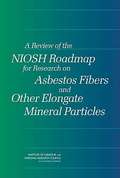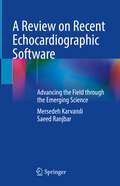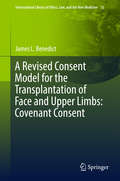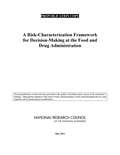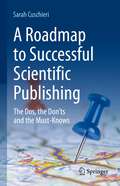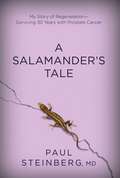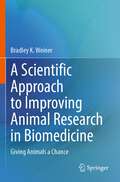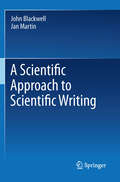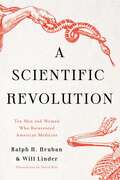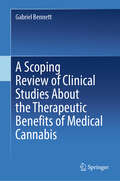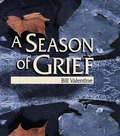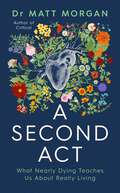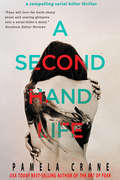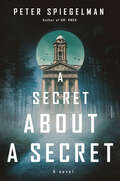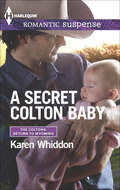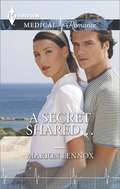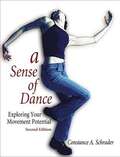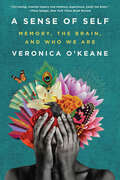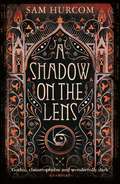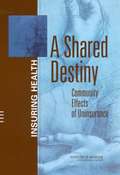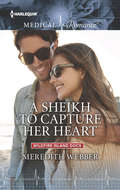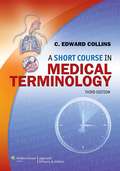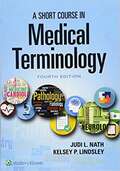- Table View
- List View
A Review of the NIOSH Roadmap for Research on Asbestos Fibers and Other Elongate Mineral Particles
by Institute of Medicine National Research Council of the National AcademiesAlthough asbestos is no longer mined in the United States, prior and ongoing exposures to asbestos continue to contribute to respiratory diseases, including mesothelioma, lung cancer, and asbestosis. To examine ongoing issues and concerns in this field, the National Institute for Occupational Safety and Health (NIOSH) drafted a research roadmap, Asbestos Fibers and Other Elongated Mineral Particles: State of the Science and Roadmap for Research, that provides an overview of the state of the science and a plan for future research in areas including toxicology, mineralogy, epidemiology, and exposure assessment. The focus of the proposed research is on clarifying the relationship between human health effects and the physical and chemical characteristics of a wide range of elongate mineral particles. In 2008, NIOSH asked the Institute of Medicine and the National Research Council to form a committee to provide a review of the scientific and technical quality of the January 2009 draft NIOSH Roadmap document. The present volume provides the committee's assessment of the Roadmap and recommendations for strengthening its utility for NIOSH, other federal agencies, the private sector, and other stakeholders.
A Review of the U.S. Workplace Wellness Market
by Soeren Mattke Christopher Schnyer Kristin Van BusumThis paper describes the current state of workplace wellness programs in the United States, including typical program components; assesses current uptake among U.S. employers; reviews the evidence for program impact; and evaluates the current use and the impact of incentives to promote employee engagement.
A Review on Recent Echocardiographic Software: Advancing the Field through the Emerging Science
by Mersedeh Karvandi Saeed RanjbarThis book provides simplified, easy-to-understand descriptions of the echocardiographic software used in conjunction with different echocardiography machines, such as those from Toshiba, Philips, GE, and Siemens, and explains how these sophisticated systems can best be used to exploit fully their ability to deliver more precise diagnoses and assist in treatment choice and follow-up. A variety of applications are covered, with presentation of algorithms and highlighting of tips and tricks. The emphasis is on the most recent advances in software and emerging benefits. In addition to its clinical relevance, the book highlights relevant links between cardiology and the basic sciences and should assist in promoting future novel research that will further advance the field. It will be of value for cardiologists, other interested clinicians, those pursuing fellowships in echocardiography, and sonographers; it will also be highly relevant for biomedical engineers, biomathematicians, computer scientists, and researchers in medical physics.
A Revised Consent Model for the Transplantation of Face and Upper Limbs: Covenant Consent (International Library of Ethics, Law, and the New Medicine #73)
by James L. BenedictThis book supports the emerging field of vascularized composite allotransplantation (VCA) for face and upper-limb transplants by providing a revised, ethically appropriate consent model which takes into account what is actually required of facial and upper extremity transplant recipients. In place of consent as permission-giving, waiver, or autonomous authorization (the standard approaches), this book imagines consent as an ongoing mutual commitment, i. e. as covenant consent. The covenant consent model highlights the need for a durable personal relationship between the patient/subject and the care provider/researcher. Such a relationship is crucial given the recovery period of 5 years or more for VCA recipients. The case for covenant consent is made by first examining the field of vascularized composite allotransplantation, the history and present understandings of consent in health care, and the history and use of the covenant concept from its origins through its applications to health care ethics today. This book explains how standard approaches to consent are inadequate in light of the particular features of facial and upper limb transplantation. In contrast, use of the covenant concept creates a consent model that is more appropriate ethically for these very complex surgeries and long-term recoveries.
A Risk-Characterization Framework for Decision-Making at the Food and Drug Administration
by National Research Council of the National AcademiesWith the responsibility to ensure the safety of food, drugs, and other products, the U.S. Food and Drug Administration (FDA) faces decisions that may have public-health consequences every day. Often the decisions must be made quickly and on the basis of incomplete information. FDA recognized that collecting and evaluating information on the risks posed by the regulated products in a systematic manner would aid in its decision-making process. Consequently, FDA and the Department of Health and Human Services (DHHS) asked the National Research Council (NRC) to develop a conceptual model that could evaluate products or product categories that FDA regulates and provide information on the potential health consequences associated with them. A Risk-Characterization Framework for Decision-Making at the Food and Drug Administration describes the proposed risk-characterization framework that can be used to evaluate, compare, and communicate the public-health consequences of decisions concerning a wide variety of products. The framework presented in this report is intended to complement other risk-based approaches that are in use and under development at FDA, not replace them. It provides a common language for describing potential public-health consequences of decisions, is designed to have wide applicability among all FDA centers, and draws extensively on the well-vetted risk literature to define the relevant health dimensions for decision-making at the FDA. The report illustrates the use of that framework with several case studies, and provides conclusions and recommendations.
A Roadmap to Successful Scientific Publishing: The Dos, the Don’ts and the Must-Knows
by Sarah CuschieriIn the age of "publish or perish," this book provides everything one needs to know about conducting research and successfully publishing it in a scientific journal. The reader learns about the complete process of scientific publishing: from selecting the most appropriate research design, to obtaining permissions and funding, to resourcefully presenting the research results in a poster and oral presentation. Additionally, the practical tips provided here help the reader formulate a compelling scientific article and choose the most suitable journal (subscription vs. the various open access modalities) for their publication.This book also addresses "invisible aspects" of scholarly publishing that are nonetheless important and that everyone should know and understand: avoiding predatory journals, understanding the editor's perspective, and becoming familiar with the various research metrics (from author to journal) that can all determine success or failure of a publication. Written in an informal style in which the author shares personal perspectives and experiences, the book is easily accessible to the reader. The book offers early career scientists in biomedicine and medicine a unique perspective on publishing research articles and how this process can enhance the authors' "scientific value" within the scientific ecosystem as well as their personal CVs.
A Salamander's Tale: My Story of Regeneration?Surviving 30 Years with Prostate Cancer
by Paul SteinbergStaring in the face of prostate cancer at age thirty-five and metastatic disease and proposed surgical castration at age forty, Paul Steinberg was forced to take two simultaneous journeys. The first was to transition from doctor to patient and surrender his physical health to a medical establishment he knew from firsthand knowledge would be using approaches that would be outdated within a few years. The second was a spiritual journey. His search for a higher meaning in his life sent him as far as walking over hot coals with Tony Robbins. Using the salamander as his role model, Steinberg, a college-health and sports psychiatrist, takes a look at the evolution of the regenerative capabilities of cold-blooded vertebrates like the salamander and at what we as humans have lost and gained in our warm-bloodedness. How do human beings regenerate? How do we redeem ourselves when our capacity for regeneration is limited? How did the prostate evolve, and how does prostate cancer develop? With wit and humor, Steinberg tackles lust and sex, and ultimately time and death and the gods. Having lived longer than virtually anyone else with metastatic prostate cancer, he uses his knowledge as a doctor and experience as a patient to provide a story of endurance and perseverance, weaving a tale of grace, regeneration, and redemption--just not the kind of regeneration and redemption that he or anyone else would expect.
A Scientific Approach to Improving Animal Research in Biomedicine: Giving Animals a Chance
by Bradley K. WeinerThis book examines animal research conducted with the goal of medical translation to humans. It is written by Dr. Bradley Weiner, a surgeon who is active at a high level clinically and in biomedical research. After documenting that the vast majority of biomedical animal research fails to result in benefits to humans via translation, the book examines the sources of such failure; including the failure to justify the use of animals, the failure to properly apply scientific methods, the failure to perform the research properly in the lab, the failure to consider the possibility of translation a priori, and systematic sources of failure built into the biomedical research enterprise. The book then explores options to improve the situation, for the benefit of both the animals and humans.
A Scientific Approach to Scientific Writing
by John Blackwell Jan MartinThis guide provides a framework, starting from simple statements, for writing papers for submission to peer-reviewed journals. It also describes how to address referees' comments, approaches for composing other types of scientific communications, and key linguistic aspects of scientific writing.
A Scientific Revolution: Ten Men and Women Who Reinvented American Medicine
by Dr. Ralph H. Hruban William LinderA prismatic examination of the evolution of medicine, from a trade to a science, through the exemplary lives of ten men and women. Johns Hopkins University, one of the preeminent medical schools in the nation today, has played a unique role in the history of medicine. When it first opened its doors in 1893, medicine was a rough-and-ready trade. It would soon evolve into a rigorous science. It was nothing short of a revolution. This transition might seem inevitable from our vantage point today. In recent years, medical science has mapped the human genome, deployed robotic tools to perform delicate surgeries, and developed effective vaccines against a host of deadly pathogens. But this transformation could not have happened without the game-changing vision, talent, and dedication of a small cadre of individuals who were willing to commit body and soul to the advancement of medical science, education, and treatment. A Scientific Revolution recounts the stories of John Shaw Billings, Max Brödel, Mary Elizabeth Garrett, William Halsted, Jesse Lazear, Dorothy Reed Mendenhall, William Osler, Helen Taussig, Vivien Thomas, and William Welch. This chorus of lives tells a compelling tale not just of their individual struggles, but how personal and societal issues went hand-in-hand with the advancement of medicine.
A Scoping Review of Clinical Studies About the Therapeutic Benefits of Medical Cannabis
by Gabriel BennettThe book delves into the rapidly evolving field of medical cannabis and its potential therapeutic applications. The importance of this topic cannot be overstated, as medical cannabis has emerged as a promising alternative or adjunctive therapy for numerous medical conditions. With the shifting legal landscape and increasing public interest, it is crucial for healthcare professionals, researchers, policymakers, and patients to have access to a comprehensive and up-to-date resource. This book aims to provide a concise and insightful resource that consolidates the findings from a wide range of clinical studies, enabling readers to gain a comprehensive understanding of the current state of knowledge in this field.
A Season of Grief
by Bill ValentineThis unique book celebrates a long-term, interracial relationship and details the everyday struggles of a surviving partner trying to carry on in a radically changed world.A Season of Grief chronicles the author's emotional descent after the violent death of his partner of 21 years. Bill Valentine's journal of fear, anger, denial, and loneliness captures the glimmers of hope, moments of serendipity, and mysterious coincidences that emerged from his full-time devotion to grief following the death of Joe Lopes. Lopes died along with 264 others when American Airlines Flight 587 crashed in November 2001 in route to the Dominican Republic. It was the second deadliest accident in U.S. aviation history. He is a word always on my lips as I try to work him into a conversation. He is a memory that I strive to keep alive. So yes, in this sense, he is not gone. But in reality, he is. He is gone as my lover. He is gone as my life partner. He is gone as my soul mate, the only person to whom I periodically bared my soul. He is gone as my best friend, the only person to whom I ever attached that label. So pardon me while I still hang on to the notion that he is not here with me. Pardon me while I cling stubbornly to the insistence that he is gone.Valentine's candid and thoughtful account of his heartbreaking efforts to make sense of his partner's death-and survive in a world without him-is by turns, funny, frightening, sobering, and surprising. In the nine months following the tragedy of Flight 587, Valentine finds every waking moment of his life affected by his partner's absence-from mundane household chores to major life decisions. A Season of Grief is a story told in darkness and light, of hurt and healing, love and loneliness, but mostly, of a man who learns to live with his partner's absence through the persistent, surprising evidence of his presence. Our job on earth is to live with uncertainty, ambiguity, and hope. We are given a limited tool set but one, in my opinion, that's sufficient for the job. Sufficient to allow us to be engaged in life-to love, grieve, work, play, celebrate, and despair. We have a remarkable ability to rebound and grow. We have been granted the capacity for wonder and laughter-especially at ourselves. These last two gifts were bestowed generously on Joe and he, in turn, taught me how vital they are.Making a strong case for gay marriage, A Season of Grief chronicles Valentine's struggles to be recognized as a surviving spouse, including a historic lawsuit with Lambda Legal Defense and Education fund against the New York State Workers Compensation Board. Valentine and Lopes took every conceivable step to formalize their relationship, including New York City Domestic Partnership, but the Workers Compensation Board and a New York State appeals court refused to recognize Valentine as a legal surviving spouse.Grief doesn't come with a set of instructions. But A Season of Grief can help guide you through the lonely journey that follows the death of a loved one. Valentine's memoir is a testament to the healing power of reality and the enduring nature of love.
A Second Act: What Nearly Dying Teaches Us About Really Living
by Dr Matt MorganI&’ve worked as a doctor for over twenty years, caring for patients who are in the thick fog between life and death. I&’ve met hundreds of people who have died, were resuscitated and lived. I&’ve long thought that these are the people that we should be listening to, not influencers or business gurus. They know what really matters. Dr Matt Morgan has met hundreds of people who&’ve come back from the dead. Their hearts stopped, their bodies unresponsive, rescued from the brink of death by the modern intensive care techniques he specialises in. People like Ed, who was walking through a park when there was a bang, a bright light and then nothing. Ed had been hit by a bolt of lightning – 300 million volts, enough to power a city for a day, coursed through his body, short-circuiting his heart. Ed was given life-saving CPR and he survived. He lives a little differently now, every day knowing the thin margins that separate life and death. In A Second Act, Morgan introduces us to patients who&’ve experienced hypothermia, overdoses, heart attacks and transplants to see how their lives have been transformed by the second chance they&’ve been given. He shares the lessons they&’ve learned, along with his own realisations about life and how to make the most of it. Life shouldn&’t be wasted on the living.
A Secondhand Life: An unpredictable serial killer thriller (The Killer Thriller Series #1)
by Pamela CraneA string of murdered girls. An innocent man behind bars. A serial killer still on the hunt.In a freak collision when she was twelve, Mia Germaine faced death and the loss of her father. A heart transplant from a young murder victim saved her life, but not without a price. Twenty years later, chilling nightmares about an unresolved homicide begin to plague Mia. Compelled by these lost memories, she forms a complicated connection to the victim—the girl killed the night of Mia’s accident—due to a scientific phenomenon called “organ memory.”Now suffocating beneath the weight of avenging a dead girl and catching a serial killer on the loose dubbed the “Triangle Terror,” Mia must dodge her own demons while unimaginable truths torment her—along with a killer set on making her his next victim.As Mia tries to determine if her dreams are clues or disturbing phantasms, a killer lures her further into danger’s path, costing her the only person who can save her.Loosely based on a true story, USA Today bestselling author Pamela Crane delivers a dark thriller about the monsters that hide in plain sight. Fans of Karin Slaughter and Lisa Gardner will relish the knife-sharp prose, empowering characters, and mind-blowing twist ending.
A Secret About a Secret: A novel
by Peter SpiegelmanA hypnotic literary mystery thriller about a murder at a secluded research facility and the secrets that it exposes. • "Cyber thievery, lust, corporate espionage, and a host of deleterious secrets comprise the chords of this sweeping, riveting symphony. A bold and original thriller by a masterful storyteller.&” —Elizabeth Brundage, author of The Vanishing PointLooming high above the cliffside along a remote coastline, Ondstrand House is the headquarters of the shadowy biotech firm Ondstrand Biologic. When the body of the organization&’s most gifted young scientist, Allegra Stans, is discovered in a walk-in refrigerator—her neck has been broken—Agent Myles is called in to investigate. Myles works for Standard Division, the most feared element of a vast state security apparatus, and he&’s been dispatched to the brooding manor, a massive stone campus that once housed a notorious boarding school, to do what Standard Division agents do best—complete the task at hand.As his investigation proceeds, Myles discovers that &“gifted scientist&” is only one thread in the complicated fabric of Allegra&’s life. There are darker strands as well—of ambition, manipulation, and bitter grievance—all woven into a pattern of secrets, each presenting a reasonable motive for murder. It appears everyone has something to hide, including Allegra&’s colleagues, lovers, and former lovers—even the very halls of Ondstrand House itself.Questions continue to pile up: What interest does Standard Division, an organization best known for intelligence gathering and clandestine international operations, have in this seemingly straightforward case? Could the killing have anything to do with the sprawling estate&’s sordid past? And what, exactly, is this research facility researching? Before long, another murder is discovered, and Myles finds himself an increasingly unwelcome presence in an ever more hostile landscape with few allies and fewer answers.
A Secret Colton Baby: Snowstorm Confessions A Secret Colton Baby The Agent's Surrender Cody Walker's Woman (The Coltons: Return to Wyoming #1)
by Karen WhiddonA new addition to Wyoming's most scandalous family Is Theo Colton the father of a baby dropped at his doorstep by a dying socialite? Even more shocked than the sexy bronc-riding champ is his beautiful cook, Ellie Parker. Just as she becomes the baby's nanny, she discovers a terrifying stalker has followed her to Dead River. What's worse-as a mysterious virus quarantines the town, danger goes viral, too. But to Theo and Ellie, the biggest dangers are their sizzling attraction and profound new feelings. Can Ellie tame the cowboy who wants nothing more than a wild ride with women? Or must she deny her heart to save his life?
A Secret Shared...
by Marion LennoxIs a secret halved...?High-flying oncologist professor Jack Kincaid isn't convinced by the treatment offered at Dolphin Bay Healing Resort. But if there's the slightest possibility that dolphins can help his little nephew Harry, he needs to give it a chance! Especially when he recognizes beautiful therapist Dr. Kate Martin-the woman he once knew as Cathy!Jack can't help but be intrigued, and he's just as attracted to her as he always was. And when Kate reveals to him the devastating secret that she will do anything to escape, not only does she share her burden, but she starts to open up Jack's locked-away heart, too....
A Sense of Self: Memory, The Brain, And Who We Are
by Veronica O'KeaneHow do our brains store—and then conjure up—past experiences to make us who we are? A twinge of sadness, a rush of love, a knot of loss, a whiff of regret. Memories have the power to move us, often when we least expect it, a sign of the complex neural process that continues in the background of our everyday lives. This process shapes us: filtering the world around us, informing our behavior and feeding our imagination. Psychiatrist Veronica O’Keane has spent many years observing how memory and experience are interwoven. In this rich, fascinating exploration, she asks, among other things: Why can memories feel so real? How are our sensations and perceptions connected with them? Why is place so important in memory? Are there such things as “true” and “false” memories? And, above all, what happens when the process of memory is disrupted by mental illness? O’Keane uses the broken memories of psychosis to illuminate the integrated human brain, offering a new way of thinking about our own personal experiences. Drawing on poignant accounts that include her own experiences, as well as what we can learn from insights in literature and fairytales and the latest neuroscientific research, O’Keane reframes our understanding of the extraordinary puzzle that is the human brain and how it changes during its growth from birth to adolescence and old age. By elucidating this process, she exposes the way that the formation of memory in the brain is vital to the creation of our sense of self.
A Shadow on the Lens: The most Gothic, claustrophobic, wonderfully dark thriller to grip you this year
by Sam Hurcom'Gothic, claustrophobic and wonderfully dark' GUARDIAN1904. Thomas Bexley, one of the first forensic photographers, is called to the sleepy Welsh village of Dinas Powys. A yound girl by the name of Betsan Tilny has been found murdered in the woodland. But the crime scene appears staged and worse still: the locals are reluctant to help.One night, he develops the crime scene photographs in the cellar of his lodgings. There, he finds a face dimly visible in the photographs - the shadowed spectre of Betsan Tilny.In the days that follow, Thomas senses a growing presence watching him as he tries to uncover what the villagers of Dinas Powys are so intent on keeping secret...The stifling, atmospheric, gothic crime novel following one of the world's first forensic photographers and featuring a killer twist - perfect for fans of The Woman in Black, The Silent Companions, and Little Strangers.****************Praise for A Shadow on the Lens:'An intriguing debut' THE TIMES'A promising debut - gothic, claustrophobic and wonderfully dark' GUARDIAN'A sparkling debut from a name to watch...You might as well be in another world. This is top notch historical crime fiction, with a dash of the supernatural. A gorgeous book and a riveting tale' David Young
A Shadow on the Lens: The most Gothic, claustrophobic, wonderfully dark thriller to grip you this year
by Sam Hurcom'Gothic, claustrophobic and wonderfully dark' GUARDIAN1904. Thomas Bexley, one of the first forensic photographers, is called to the sleepy Welsh village of Dinas Powys. A yound girl by the name of Betsan Tilny has been found murdered in the woodland. But the crime scene appears staged and worse still: the locals are reluctant to help.One night, he develops the crime scene photographs in the cellar of his lodgings. There, he finds a face dimly visible in the photographs - the shadowed spectre of Betsan Tilny.In the days that follow, Thomas senses a growing presence watching him as he tries to uncover what the villagers of Dinas Powys are so intent on keeping secret...The stifling, atmospheric, gothic crime novel following one of the world's first forensic photographers and featuring a killer twist - perfect for fans of The Woman in Black, The Silent Companions, and Little Strangers.****************Praise for A Shadow on the Lens:'An intriguing debut' THE TIMES'A promising debut - gothic, claustrophobic and wonderfully dark' GUARDIAN'A sparkling debut from a name to watch...You might as well be in another world. This is top notch historical crime fiction, with a dash of the supernatural. A gorgeous book and a riveting tale' David Young
A Shared Destiny: Community Effects of Uninsurance
by Committee on the Consequences of UninsuranceA Shared Destiny is the fourth in a series of six reports on the problems of uninsurance in the United States. This report examines how the quality, quantity, and scope of community health services can be adversely affected by having a large or growing uninsured population. It explores the overlapping financial and organizational basis of health services delivery to uninsured and insured populations, the effects of community uninsurance on access to health care locally, and the potential spillover effects on a community’s economy and the health of its citizens. The committee believes it is both mistaken and dangerous to assume that the persistence of a sizable uninsured population in the United States harms only those who are uninsured.
A Sheikh to Capture Her Heart
by Meredith WebberRunning from her past...into his arms? Four years after the tragedy that drove her to Wildfire Island, flying surgeon Sarah Watson is ready to live again. Starting with a steamy affair with mysterious Harry... But this resident hunk is running, too-from the injury that ended his career as a surgeon and his duties as Sheikh Rahman al-Taraq of Ambelia! When their one-week fling overruns, Sarah and Harry must choose: keep running or stand firm...together.
A Short Course in Medical Terminology
by C. Edward CollinsMaster the medical terminology you need for your future career with A Short Course in Medical Terminology, 3rd Edition and its accompanying back-of-the-book and online resources. Using a concise mnemonic approach, this book shows you how to memorize word parts and use word building to learn medical terminology. The book covers terminology related to structure and function, diseases and disorders, abbreviations, medical specialties (including pharmacology), and health professions. Mastery of key terms is easy with the book's hundreds of fun and engaging in-text, , and online exercises, including new flashcard and audio pronunciation activities, crossword puzzles, Hangman, medical case record and spelling bee questions, figure labeling exercises, and true/false, fill-in-the-blank, and multiple choice exercises. Connect what you are learning to clinical practice with redesigned Case Studies that highlight the role medical terminology plays in communication. Easily master medical terminology with a wide variety of exercises integrated into the narrative for fun and efficient practice. Reinforce your understanding with the book's concise and user-friendly approach, logical organization, and study tables that summarize chapter terms in an easy-to-reference format Increase your mastery with Word Sense features that highlight fun facts about medical or easily confused terms. Increase your understanding of word parts, definitions, and abbreviations with Word Elements and Abbreviations tables. Check your understanding of key terms with Chapter Quizzes.
A Short Course in Medical Terminology
by Judi L. NathRetaining its logical organization, body systems approach, and focus on word parts, word building, and word analysis; this Fourth Edition of A Short Course in Medical Terminology reflects current medical usage and is now even more concise, student-friendly, and accessible. <p><p> This edition features an enhanced art and design program, a more standardized chapter structure, and a vast array of in-text and online learning resources that help students master the language of medicine as they prepare for practice in today’s rapidly changing healthcare environment.
